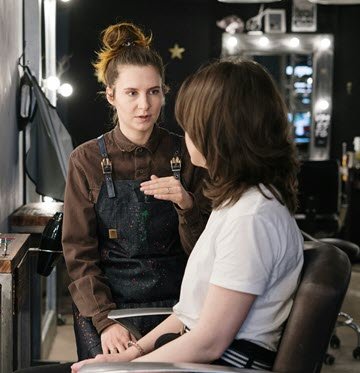Fascinating Facts About Hairdressers
 Hairdressers play a vital role in our lives, shaping not only our hair but also our confidence and self-image. Their expertise goes beyond mere styling; they possess a wealth of knowledge about hair health, trends, and techniques. Here, we explore fascinating facts about hairdressers that highlight their importance and the artistry involved in their craft.
Hairdressers play a vital role in our lives, shaping not only our hair but also our confidence and self-image. Their expertise goes beyond mere styling; they possess a wealth of knowledge about hair health, trends, and techniques. Here, we explore fascinating facts about hairdressers that highlight their importance and the artistry involved in their craft.
The Evolution of Hairdressing
Hairdressing is an ancient profession, with evidence of hairstyling dating back to ancient Egypt. Egyptians used various tools and techniques to create intricate hairstyles, often adorned with accessories. Over centuries, hairdressing has evolved, influenced by cultural shifts and fashion trends. Today, hairdressers blend traditional techniques with modern innovations to create stunning looks.
Historical Roots
- Ancient Egypt: Hair was often styled with oils and adorned.
- Middle Ages: Haircuts became symbolic of social status, with elaborate styles reserved for nobility.
- Renaissance: Hairdressing flourished as artists began to depict intricate hairstyles in their works.
The Importance of Training
Becoming a professional hairdresser requires extensive training. Aspiring stylists typically attend hairdressing colleges or schools, where they learn about hair types, cutting techniques, colour theory, and customer service. This education equips them with the skills necessary to excel in the industry.
Key Training Aspects
- Cutting Techniques: Mastery of various cutting styles, from blunt cuts to layers.
- Colouring Knowledge: Understanding colour theory and the chemical processes involved.
- Client Interaction: Developing strong communication skills to understand client needs.
Creativity is at the heart of hairdressing. Hairdressers must envision styles that enhance their clients’ features while considering current trends. This artistic flair allows them to transform ordinary hair into extraordinary works of art.
Creative Expression
 Custom Styles: Tailoring looks to suit individual personalities.
Custom Styles: Tailoring looks to suit individual personalities.- Innovative Techniques: Experimenting with new methods and products to achieve unique results.
- Trendsetting: Influencing fashion by introducing new styles that become popular.
The Science of Hair
Hairdressers possess a deep understanding of the science behind hair. They know how different hair types react to various products and treatments, allowing them to recommend the best options for their clients.
Hair Structure
- Hair Follicles: The roots of hair that determine growth patterns and health.
- Cuticle Layers: Protecting the inner structure of hair and influencing shine and texture.
- pH Balance: Understanding the importance of maintaining the right pH for healthy hair.
Tools of the Trade
Hairdressers use a variety of tools to achieve their desired results. From scissors to styling products, each tool has a specific purpose and contributes to the overall process.
Essential Tools
- Scissors: Different types for various cutting techniques.
- Combs and Brushes: Used for detangling and styling.
- Heat Tools: Curling irons and straighteners for creating diverse looks.
The Business Side of Hairdressing
While creativity is essential, hairdressers must also navigate the business aspects of their profession. Many operate their own salons or work as freelancers, requiring knowledge of marketing, customer service, and financial management.
Business Skills
- Client Retention: Building lasting relationships to encourage repeat visits.
- Marketing Strategies: Utilizing social media and local advertising to attract new clients.
- Financial Management: Keeping track of expenses and income to ensure profitability.
Trends in Hairdressing
 The hairdressing industry is constantly evolving, with new trends emerging regularly. Hairdressers must stay informed about the latest styles, techniques, and products to meet client demands.
The hairdressing industry is constantly evolving, with new trends emerging regularly. Hairdressers must stay informed about the latest styles, techniques, and products to meet client demands.
Current Trends
- Sustainable Practices: An increasing focus on eco-friendly products and methods.
- Diverse Hair Textures: Embracing all hair types and textures in styling.
- Personalised Services: Tailoring services to individual client needs for a more unique experience.
The Impact of Technology
Technology has transformed the hairdressing industry, from advanced tools to online booking systems. Hairdressers can now offer a more efficient and streamlined experience for their clients.
Technological Advancements
- Online Booking: Simplifying the appointment process for clients.
- Virtual Consultations: Offering advice and consultations through video calls.
- Smart Tools: Using heat-controlled styling tools to minimise damage.
Hairdressers often form strong emotional bonds with their clients. Some clients view their stylist as a confidant, sharing personal stories and experiences during appointments.
Building Trust
- Active Listening: Paying attention to clients’ needs and concerns.
- Empathy: Understanding and relating to clients’ emotions.
- Creating a Safe Space: Fostering an environment where clients feel comfortable expressing themselves.
The Importance of Continuing Education
To remain competitive, hairdressers must engage in continuous learning. This includes attending workshops, seminars, and industry events to stay updated on new techniques and products.
Lifelong Learning
- Workshops: Hands-on training to learn new skills.
- Industry Events: Networking opportunities and exposure to the latest trends.
- Online Courses: Flexible learning options to enhance knowledge.
Hairdressers and Self-Care
The nature of hairdressing can be physically demanding. Hairdressers must prioritise self-care to maintain their health and well-being while providing top-notch services.
Self-Care Practices
- Ergonomics: Using proper posture and tools to prevent injuries.
- Work-Life Balance: Setting boundaries to avoid burnout.
- Stress Management: Incorporating relaxation techniques into their routines.
Cultural Significance of Hairdressing
Hairdressing holds significant cultural importance across various communities. Different hairstyles can signify social status, cultural identity, and personal expression.
Cultural Perspectives
- Traditional Styles: Hairstyles that reflect cultural heritage and history.
- Modern Influences: The blending of traditional and contemporary styles.
- Cultural Celebrations: Hairdressing as a form of art during significant life events.
Conclusion
The world of hairdressing is rich with history, creativity, and emotional connections. Hairdressers not only enhance physical appearances but also contribute to their clients’ self-esteem and confidence. Understanding these fascinating facts about hairdressers can deepen our appreciation for their artistry and dedication to their craft. Whether you’re considering a career in hairdressing or simply seeking to understand the profession better, these insights reveal the multifaceted nature of this essential industry.
We hope you have enjoyed this Article on Fascinating Facts About Hairdressers

